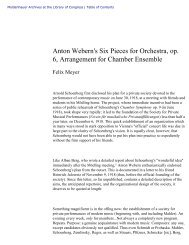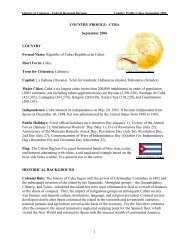1 - American Memory
1 - American Memory
1 - American Memory
Create successful ePaper yourself
Turn your PDF publications into a flip-book with our unique Google optimized e-Paper software.
Even with phase 1 of the wage-price freeze in eflFect beginning in<br />
mid-August, Honolulu food prices jumped 4.5 percent between June<br />
and October 1971. By contrast, U.S. food prices declined 0.3 percent<br />
during the same period. By February 1972—after 115 cumulative days<br />
of the west coast longshore strike and despite relief through an 80-day<br />
Taft-Hartley injimction and two voluntary extensions—a head of<br />
lettuce cost 72 cents, a dozen oranges $1.45, and 10 pounds of potatoes<br />
$2.28 on the average.<br />
Local retailers, responding to a survey on the impact of the west<br />
coast longshore strike, reported sales declines ranging up to 17 percent.<br />
Construction-generated earnings declined 7.8 percent in 1971 and<br />
rose a mere 2.4 percent in 1972.<br />
The annual increase in State tax collections fell from 12 percent<br />
in 1970 to 7.5 percent in 1971 and 7.9 percent in 1972.<br />
Personal income growth fell from 14.1 percent in 1970, nearly twice<br />
the national average, to 6.4 percent in 1971.<br />
Hawaii's per capita personal income soared 11.3 percent in 1970,<br />
which compared very favorably with the national gain of 6.3 percent.<br />
In 1972, however, it increased only 4.1 percent. Only seven States had<br />
lower per capita personal income growtli rates than Hawaii that year,<br />
and the national gain was 5.6 percent. In 1972, still plagued by ship-<br />
ping problems and their resultant impact on business activity, per<br />
capita personal income in Hawaii increased only 5.9 percent, com-<br />
pared with the national growth rate of 7.9 percent. Only three States<br />
had a smaller per capita personal income growth rate than Hawaii<br />
in 1972.<br />
In 1970 Hawaii's personal income was the sixth highest in the Na-<br />
tion—exceeded by only four States and the District of Columbia. The<br />
blows to the economy which came during the strike years lowered<br />
Hawaii's ranking to ninth in 1971, where is remained m 1972.<br />
A major cost of the ever-present strike threat in Hawaii is the fact<br />
that it compels our businessmen to keep very large inventories on hand<br />
at all times. This stockpiling, which greatly increases the cost of doing<br />
business, is passed on to the consumer and contributes significantly to<br />
the high cost of living in Hawaii.<br />
Shipping tieups also have serious long-range repercussions on the<br />
State of E^waii. The principal impact is to make it more difficult to<br />
attract investment capital. For the last 20 years or more, the economic<br />
growth of Hawaii has been financed in large part by capital attracted<br />
from outside the State. This is true because local funds are inadequate,<br />
because savings of Hawaii residents are often funneled into mainland<br />
opportunities, and because out-of-State owners of Hawaiian enter-<br />
prises return profits to home offices located on the mainland or in a<br />
foreign country.<br />
Personal savings and business profits, therefore, tend to flow out of<br />
Hawaii, and the economic development of my State depends upon local<br />
ability to attract outside investment funds. Shipping interruptions can<br />
BO shake investor confidence that the capacity to attract such funds is<br />
dealt a severe setback.<br />
Finally, and very importantly, shipping strikes imperil or destroy<br />
markets for Hawaii's export industries, which are principally sugar<br />
and pineapple. The primary market for Hawaii sugar, for instance, is<br />
in the Western States, where sugar is already in surplus supply. In the<br />
past, shipping interruptions have caused Hawaii sugar producers to



![Albert Einstein Papers [finding aid]. Library of Congress. [PDF ...](https://img.yumpu.com/21604228/1/190x245/albert-einstein-papers-finding-aid-library-of-congress-pdf-.jpg?quality=85)





![American Colony in Jerusalem Collection [finding aid]. Library of ...](https://img.yumpu.com/17941275/1/190x245/american-colony-in-jerusalem-collection-finding-aid-library-of-.jpg?quality=85)



![Piccard Family Papers [finding aid]. - American Memory - Library of ...](https://img.yumpu.com/17941234/1/190x245/piccard-family-papers-finding-aid-american-memory-library-of-.jpg?quality=85)


